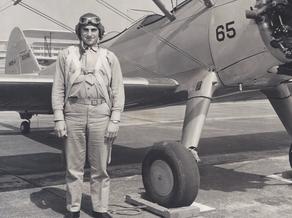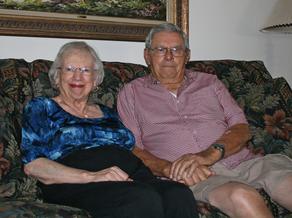
As a young boy in Winthrop Iowa, Harlan Foote saw an airplane flying around his farm and landing in a nearby field. The experience set in motion, an interest in aviation that would wind up leading him to a 23-year flying career in the U.S. Navy.
As a young boy in Winthrop Iowa, Harlan Foote saw an airplane flying around his farm and landing in a nearby field. The experience set in motion, an interest in aviation that would wind up leading him to a 23-year flying career in the U.S. Navy.
It was a career that had much of its beginning tied to the Joint Forces Training Base, then known as the Naval Air Station. Foote, 90, eventually returned to live in Seal Beach, just a few thousand feet from the runway where he made his first solo flight and launched a career that included many combat battles in World War II. Of course, the area around the JFTB has changed dramatically since his 1942 training.
“When we were flying from here on Seal Beach Boulevard, right where the shopping center is now, there was a dog food factory and when you took off this direction with an open cockpit you could smell it, and you’d go the other way and there were orange fields out there,” Foote said.
Foote began his naval flight training as one of the first classes to start training out of the Naval Air Station. The base was officially commissioned in May of 1942, and Foote and his 36 classmates began their training in July of that same year. According to Foote, the base was the primary early stage flight-training base for World War II naval pilots.
“Then they sent them off to Corpus Christi or Pensacola where we graduated from,” Foote said.
After working their way up to a solo flight, the class was sent out onto makeshift aircraft carriers that had been converted from oil tankers. Foote had moved to Ventura California in 1937 and he would later enroll at Ventura Junior College in their civilian pilot training program. But after the attack on Pearl Harbor, the flight training was moved to an airfield outside Baker, California for two weeks at a time.
While training at Baker, Foote missed a final exam and was given an F by the instructor. That led Foote to leave Ventura College and enroll in the Navy. For Foote and many of his classmates, who were also former civilian pilot trainees, the military regimen of marching and learning to handle the sword they were given, was more difficult than flight training.
One of his classmates was a man named David Asbury. Upon graduation as a Naval Aviator in March of 1943, Foote married his college sweetheart, Marjorie Jensen. Asbury would marry a woman named Nadine Nepveu. The four remained close friends, though Marjorie would die in 1994, five years after Asbury suffered a fatal heart attack in 1989.
By 1995, Foote and Nadine had married and have spent the past 17 years as husband and wife. Their passion for travel kept them busy with various cruises all around the world. Their marriage gave them both a new lease on life after losing their first spouses.
“We’ve had a glorious life together, the two of us,” Foote said.
Foote spent a total of 36 years involved with the Navy, 23 as a naval pilot. When he was told he was too old to continue to fly off of aircraft carriers, he decided to take a civilian job at the Pentagon. During his 23 years, he was part of battles over the Marshall Islands and the Gilbert Islands. He flew off multiple carriers, including the USS Hornet, a historic WWII Aircraft Carrier that is now a museum on the San Francisco Bay. Foote was awarded a Navy Cross, Distinguished Flying Cross and four Air Medals. Foote would also serve during the Korean War and accumulated more than 5,000 hours of flight time. He eventually earned a degree from the University of Maryland, by taking courses while working at the Pentagon.
Foote said he has had three loves in his life, Marjorie, Nadine and aviation.
“I love to fly airplanes,” Foote said.

